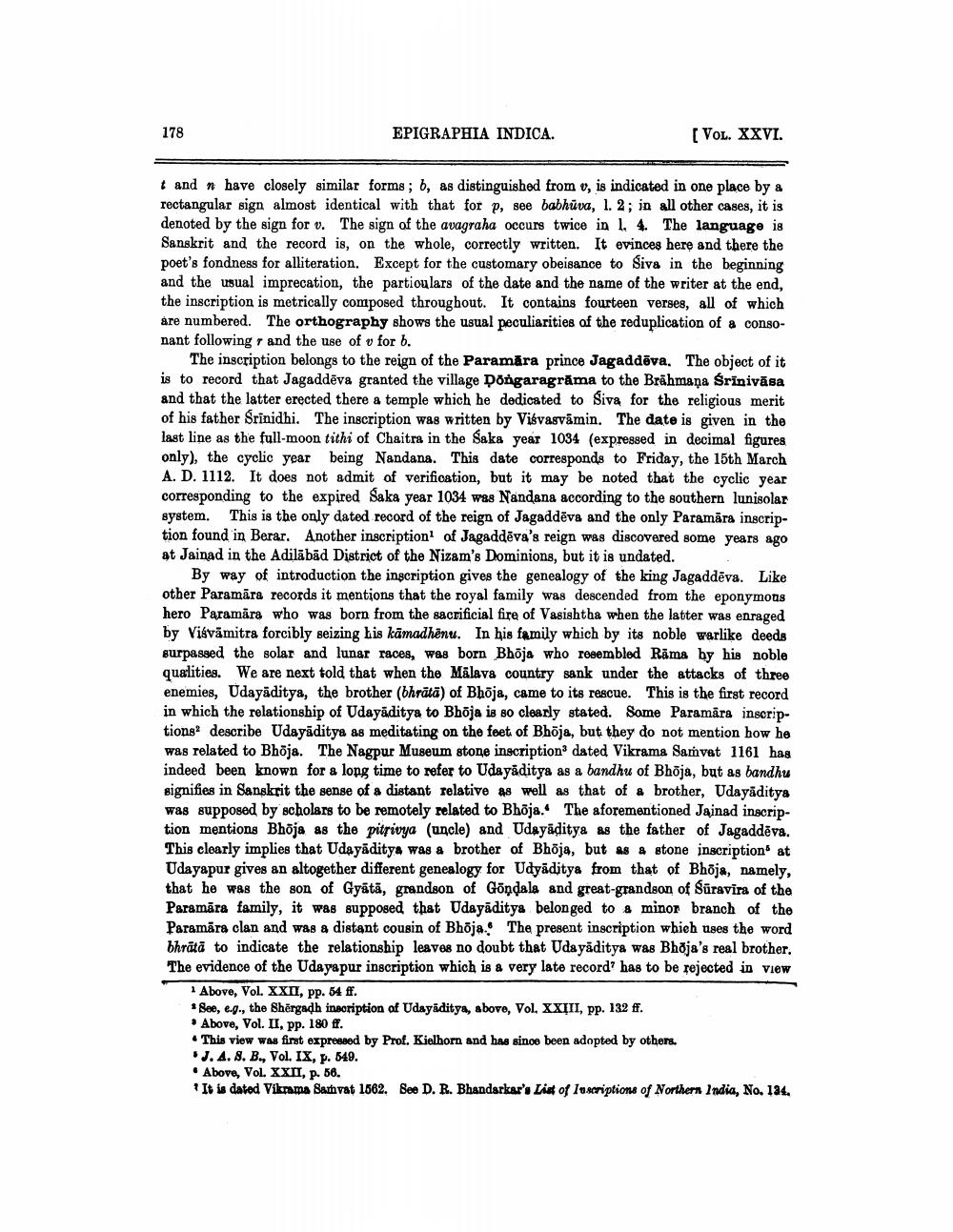________________
178
EPIGRAPHIA INDICA.
(VOL. XXVI.
and n have closely similar forms; b, as distinguished from v, is indicated in one place by a rectangular sign almost identical with that for p, see babhüva, 1. 2; in all other cases, it is denoted by the sign for v. The sign of the avagraha occurs twice in l. 4. The language is Sanskrit and the record is, on the whole, correctly written. It evinces here and there the poet's fondness for alliteration. Except for the customary obeisance to Siva in the beginning and the usual imprecation, the partioulars of the date and the name of the writer at the end, the inscription is metrically composed throughout. It contains fourteen verses, all of which áre numbered. The orthography shows the usual peculiarities of the reduplication of a consonant following r and the use of v for b.
The inscription belongs to the reign of the Paramāra prince Jagaddāva. The object of it is to record that Jagaddēva granted the village Dongaragrāma to the Brahmana Srinivāsa and that the latter erected there a temple which he dedicated to Siva for the religious merit of his father Srinidhi. The inscription was written by Visvasvamin. The date is given in the last line as the full-moon tithi of Chaitra in the Saka year 1034 (expressed in decimal figures only), the cyclic year being Nandana. This date corresponds to Friday, the 15th March A. D. 1112. It does not admit of verification, but it may be noted that the cyclic year corresponding to the expired Saka year 1034 was Nandana according to the southern lunisolar system. This is the only dated record of the reign of Jagaddēva and the only Paramāra inscription found in Berar. Another inscription of Jagaddēva's reign was discovered some years ago at Jainad in the Adilābād District of the Nizam's Dominions, but it is undated.
By way of introduction the inscription gives the genealogy of the king Jagaddēva. Like other Paramāra records it mentions that the royal family was descended from the eponymous hero Paramāra who was born from the sacrificial fire of Vasishtha when the latter was enraged by Visvāmitra forcibly seizing his kāmadhënu. In his family which by its noble warlike deeds gurpassed the solar and lunar races, was born Bhöja who resembled Rāma by his noble qualities. We are next told that when the Mālava country sank under the attacks of three enemies, Udayāditya, the brother (bhrātā) of Bhoja, came to its rescue. This is the first record in which the relationship of Udayāditya to Bhoja is so clearly stated. Some Paramära inscriptions describe Udayāditya as meditating on the feet of Bhöja, but they do not mention how he was related to Bhöja. The Nagpur Museum stone inscription dated Vikrama Samvet 1161 has indeed been known for a long time to refer to Udayaditya as a bandhu of Bhöja, but as bandhu signifies in Sanskrit the sense of a distant relative as well as that of a brother, Udayaditya was supposed by scholars to be remotely related to Bhöja. The aforementioned Jainad inscription mentions Bhoja as the pitfivya (uncle) and Udayāditya as the father of Jagaddēva. This clearly implies that Udayāditya was a brother of Bhöja, but as a stone inscription at Udayapur gives an altogether different genealogy for Udyāditya from that of Bhoja, namely, that he was the son of Gyātā, grandson of Göndala and great-grandson of Sūravira of the Paramāra family, it was supposed that Udayāditya belonged to a minor branch of the Paramāra clan and was a distant cousin of Bhoja. The present inscription which tses the word bhrātā to indicate the relationship leaves no doubt that Udayāditya was Bhoja's real brother, The evidence of the Udayapur inscription which is a very late record? has to be rejected in view
1 Above, Vol. XXII, pp. 54 f. * See, e.g., the Shërgadh insoription of Udayaditya, above, Vol. XXIII, pp. 132 ff. • Above, Vol. II, pp. 180 ff. • This view was first expressed by Prof. Kielhorn and has since been adopted by others.
J. A. 8. B., Vol. IX, p. 549. . Above, Vol. XXII, p. 56. ? It is dated Vikrama Samvat 1562. See D. R. Bhandarkar's List of Inscriptions of Northern India, No. 124.




